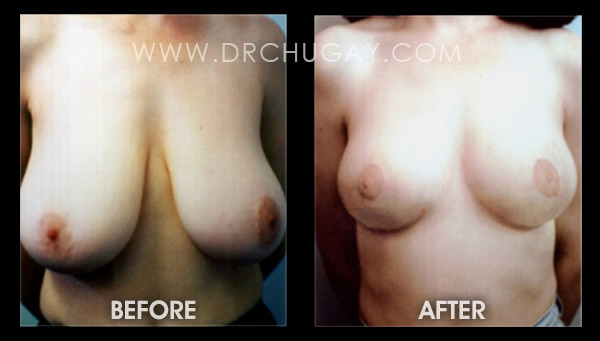Breast Reduction Surgery
Both in the past and present, the breast has been one of the key attributes of
Female and Male Physical Identity.
The size, appearance and shape of the breast have assumed great importance to both the patient herself and her admirers.
Large uncomfortable breasts may cause understandable and frequently severe psychological distress. There are also physical factors to consider: women with very large, pendulous breasts may experience a variety of medical problems caused by the excessive weight-from back and neck pain and skin irritation to skeletal deformities and breathing problems.
Breast reduction surgery (Reduction Mammaplasty) is ideal for patients with excessively large breasts. The procedure allows removal of a portion of the breast gland, skin, fat and other tissues making breasts smaller, shapelier and firmer with better shaped and positioned nipples.
What is Unique about Dr. Chugay’s Technique?
Dr. Chugay has perfected his own variation of the Breast Reduction procedure originally developed by famous Brazilian plastic surgeon, Ivo Pitanguy in Long Beach, CA.
A triangular cut is made around the areola then extended to the inframammary line in a keel-shaped wedg. Skin and gland are then removed as a whole unit. Then, the breast cone is sutured together from within, giving a natural round shape. The nipple is placed usually about 21 cm below the mid-clavicle (collar bone) and skin is sutured with a subcuticular stitch.
Is Financing Available?
Yes! Medical Financing is available on approved credit. We accept financing from CareCredit.com. For more information about our Financing options
Why is Dr. Chugay’s Procedure better Than the Traditional Technique?
This procedure preserves good circulation to the nipple. Loss of circulation is very rare, but when it occurs, skin necrosis in the nipple area can develop. This technique is a very safe procedure. The traditional technique involves removal of long narrow strips of gland and skin. The strips are folded upon themselves, which can cause loss of circulation. The surgeon then brings the skin from both sides of the breast down and around the areola, shaping the new contour of the breast. Unfortunately, 80% of surgeons in the United States still use the traditional Breast Reductions technique.
Things to Look for In your Surgeon:
- Experience: With 2 generations of doctors, over 30,000 procedures and a lifetimes worth of combined experience, Dr. Nikolas V. Chugay and Dr. Paul N. Chugay have not only the required experience in various surgical and non surgical procedures but Nikolas has helped revolutionize the industry, and Paul is following very closely in his father’s footsteps, drawing on over 40 years of experience.
- Compatibility & Respect: Book a consultation with the doctor. Get a feel for how they treat you; whether they listen to you and what you want. It’s important to thoroughly discuss what you’re trying to achieve with your doctor so they have a clear, concise idea of what your goal is but it’s equally important that you respect your doctor’s experience and education enough to listen to their recommendations. You don’t want a doctor that doesn’t care about YOU.
- Specialization: Ask your doctor about other times they’ve performed the procedure you want.
After Breast Reduction Surgery
After surgery, you’ll be wrapped in an elastic bandage or a surgical bra over gauze dressings. A small tube may be placed in each breast to drain off blood and fluids for the first day or two.
You may feel some pain for the first couple of days-especially when you move around or cough-and some discomfort for a week or more. Dr. Chugay will prescribe medication to ease any pain and discomfort.
The bandages will be removed a day or two after surgery, though you’ll continue wearing the surgical bra around the clock for several weeks, until the swelling and bruising subside. Your stitches will be removed in one to three weeks.
If your breast skin is very dry following surgery, you can apply a moisturizer several times a day, but be sure to keep the suture area dry.



